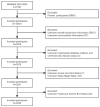Age-Dependent Effects of Homocysteine on Erectile Dysfunction Risk Among U.S. Males: A NHANES Analysis
- PMID: 39378081
- PMCID: PMC11462577
- DOI: 10.1177/15579883241278065
Age-Dependent Effects of Homocysteine on Erectile Dysfunction Risk Among U.S. Males: A NHANES Analysis
Abstract
Erectile dysfunction (ED) is a common problem that seriously impacts men's quality of life and mental health. Earlier studies have indicated that homocysteine (HCY) levels might be linked to the risk of ED, although these studies are limited by small sample sizes and insufficient correction for confounding factors. This study uses data from the 2001-2004 National Health and Nutrition Examination Survey (NHANES) to evaluate the relationship between HCY levels and ED risk in U.S. adult males. The analysis involved using a weighted generalized linear model to assess main effects and restricted cubic splines (RCS) to explore nonlinear relationships. Results showed that the association between HCY and ED was not statistically significant after adjusting for covariates. However, interaction analyses between age and the HCY-ED relationship showed that as age increases, the impact of HCY on ED strengthens. Based on this, subgroup analysis by age was carried out, revealing that in people aged 50 and above, HCY levels were significantly positively correlated with ED, especially when HCY levels exceeded 9.22 μmol/L, significantly increasing the risk of ED. Sensitivity analysis further confirmed the robustness of these findings. This study indicates that controlling HCY levels, especially in middle-aged and older men, might help prevent and treat ED, providing a foundation for future preventive strategies.
Keywords: National Health and Nutrition Examination Survey; cross-sectional study; erectile dysfunction; homocysteine.
Conflict of interest statement
Declaration of Conflicting InterestsThe author(s) declared no potential conflicts of interest with respect to the research, authorship, and/or publication of this article.
Figures




Similar articles
-
Association between composite dietary antioxidant index and erectile dysfunction among American adults: a cross-sectional study.Sci Rep. 2024 Sep 11;14(1):21230. doi: 10.1038/s41598-024-72157-w. Sci Rep. 2024. PMID: 39261605 Free PMC article.
-
Association between ankle-brachial blood pressure index and erectile dysfunction in US adults: a large population-based cross-sectional study.Front Endocrinol (Lausanne). 2024 Jul 26;15:1436043. doi: 10.3389/fendo.2024.1436043. eCollection 2024. Front Endocrinol (Lausanne). 2024. PMID: 39129923 Free PMC article.
-
Association between homocysteine, vitamin B 12 , folic acid and erectile dysfunction: a cross-sectional study in China.BMJ Open. 2019 May 22;9(5):e023003. doi: 10.1136/bmjopen-2018-023003. BMJ Open. 2019. PMID: 31122963 Free PMC article.
-
Serum Homocysteine Levels in Men with and without Erectile Dysfunction: A Systematic Review and Meta-Analysis.Int J Endocrinol. 2018 Aug 7;2018:7424792. doi: 10.1155/2018/7424792. eCollection 2018. Int J Endocrinol. 2018. PMID: 30158975 Free PMC article. Review.
-
Association of homocysteine level with risk of stroke: A dose-response meta-analysis of prospective cohort studies.Nutr Metab Cardiovasc Dis. 2020 Oct 30;30(11):1861-1869. doi: 10.1016/j.numecd.2020.07.026. Epub 2020 Jul 24. Nutr Metab Cardiovasc Dis. 2020. PMID: 32912796
References
-
- Ahmad A., Corban M. T., Toya T., Sara J. D., Lerman B., Park J. Y., . . .Lerman A. (2020). Coronary microvascular endothelial dysfunction in patients with angina and nonobstructive coronary artery disease is associated with elevated serum homocysteine levels. Journal of the American Heart Association, 9(19), Article e017746. 10.1161/jaha.120.017746 - DOI - PMC - PubMed
MeSH terms
Substances
LinkOut - more resources
Full Text Sources
Medical

